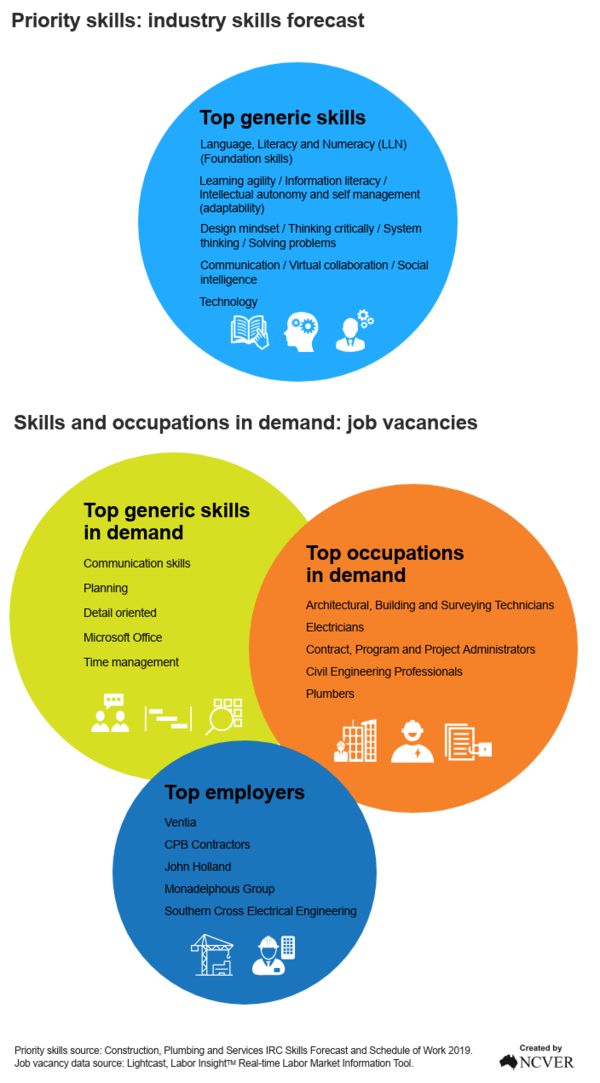
Industry insights on skills needs
According to the Construction, Plumbing and Services IRC's 2019 Skills Forecast the top generic skills required for the Construction industry are:
- Language, Literacy and Numeracy (LLN)
- Learning agility/Information literacy/Intellectual autonomy and self-management
- Design mindset/Thinking critically/System thinking/Solving problems
- Communication/Virtual collaboration/Social intelligence
- Technology.
The National Skills Commission’s Skills Priority List (2022) identifies the following as experiencing skill shortages Construction Project Manager, Bricklayer and Stonemason, Carpenter and Joiner, Fibrous Plasterer, Plumber (General), Wall and Floor Tiler, Painting Trades Worker, and Roof Tiler. Further, national future demand for these occupations was rated as soft to moderate, according to the Skills Priority List.
According to the job vacancy data, the top requested skills by employers were communication skills, planning and being detail-orientated. The most advertised Construction occupations were Architectural, Building and Surveying Technicians, followed by Electricians, and Contract, Program and Project Administrators. The top employers in this industry were Ventia, CPB Contractors, and John Holland.
The Construction, Plumbing and Services IRC’s 2020 Skills Forecast was the final skills forecast published by the IRC. It identified industry workforce practices, skills development, and trends, which emerged between the publication of 2019 Skills Forecast and the 2020 update. It reported that new developments in existing and emerging specialisations within the sector required tailored training solutions. Further, modern methods of construction were increasing reliance on new technologies changing skill needs as construction becomes more digitised. Increased industry recognition of workplace hazards also required training and skills development.
According to the 2020 Skills Forecast, the major new workforce skills and trends that emerged between the submission of the 2019 and 2020 Skills Forecasts were:
- Demand for occupational skills due to the shift to hydrogen in the gas supply
- Greater awareness of construction workplace hazards, in particular asbestos safety awareness, silicosis safety awareness and mental health safety awareness
- Demand for heritage skills
- Demand for prefabricated concrete construction installation skills.
Additionally, the Construction, Plumbing and Services IRC reported it received direct requests for training products to address industry skills needs in:
- Rope work
- Water Efficiency Labelling and Standards (WELS) scheme
- Cured in Place Pipe – unit of competency
- Steel Construction – unit of competency
- Swimming Pool and Spa Building Certificate III.
The 2020 Skills Forecast also reported these trends were emerging within an existing environment of continuing and intensifying regulation and environment changes. The latter, through climate change and events were stimulating geographic demand for skills and occupations in the construction industry. These concerns were also having an impact on insurance requirements, which resulted in strengthened regulation in response to building failures.
Another regulatory requirement for construction workers was obtaining a White Card to work or access construction sites. The CPCCWHS1001 Prepare to Work Safely in the Construction Industry project explored possible amendments to the assessment requirements of the unit of competency to address industry concerns around assessment quality, online identity fraud and appropriate language and literacy. The Case for Endorsement was approved in late 2021 and the project completed in 2022.
The use of technology presents opportunities and challenges for the Construction industry, particularly around skill needs. The use of artificial intelligence in the construction industry, in particular how it can optimise and improve process-drive operations across each phase of the construction project lifecycle was explored in AI: construction’s new frontier of digital enablement. The use of digital twin technology, that is a ‘virtual representation of real-world entities and processes, synchronised a specified frequency and fidelity’ was explored in Digital Twin: the Age of Aquarius in Construction and Real Estate. The report provided an insight into how digital twin enables a physical building to adapt to human needs, instead of humans conforming to the building’s limitations. According to the authors, it provided data that can deliver actionable insights geared towards efficiency while reducing wasted resources.
Separately, mental health in the construction industry was the focus of The Impact of Workplace Bullying on Mental Health and Suicidality in Queensland Construction Industry Apprentices and was an issue discussed in the NT Industries: Construction and the CSQ Training Plan for 2021-2022.

